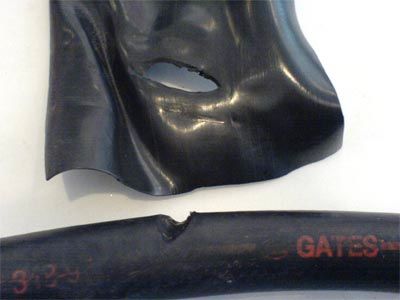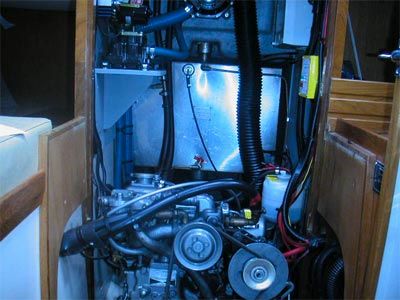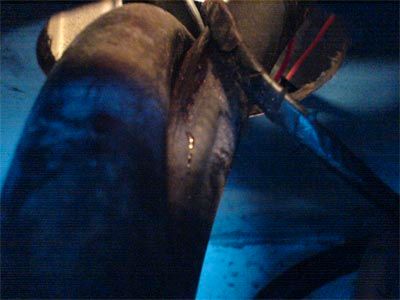Mysterious Coolant Leak
15/11/05 19:21 Filed in: Engine
The Yanmar 2GM was checked over in the yard prior to delivery in August 2005 by the local Yanmar dealer. All appeared OK. Due to a lack of wind we had to motor all the way and the engine performed faultlessly.
On the next visit the engine was checked over. The coolant was quite low and the alternator belt had become quite loose. The belt was tightened but the reason why coolant level had dropped so far was not immediately apparent.
After topping up the coolant gradually disappeared each time the engine was run but there were no apparent leaks from the engine and no coolant in the bilge.
The problem was temporarily dealt with by regularly topping up the coolant reservoir.
Finally, at lay-up while winterising the engine, the cause of the loss was found.
Two coolant hoses pass through the starboard engine room bulkhead to the domestic hot water calorifier. A circular hole had been cut to facilitate this access but the edges had not been smoothed and were very sharp.
The builders had protected the hoses with PVC wrap but this proved insufficient against the sharp GRP edges on the bulkhead hole. Over 500 hours of engine use the PVC wrap and then one hose had rubbed against the sharp GRP and been sawn through.
This resulted in a V cut into one hose causing an initially tiny but gradually increasing coolant leak. Coolant leaked from the hose into a starboard lower locker and flowed forward under the fridge box before accumulating in the starboard lower locker under the chart table.
At initial inspection and again at survey a sticky residue had been noted in this locker but we had been unable to identify the source.
All was now clear. The residue remained after small volumes of leaked coolant had evaporated. At layup several litres of coolant remained in the locker.
A very annoying problem resulting from questionable hose run protection which would have emerged much earlier on a more regularly used boat and likely been covered under warranty.
Stlll a satisfying outcome which required only a £10 length of hose and adequately robust run protection to put right.
Calorifier Bay. Black hose at the bottom is the culprit.

Hose wrap and hose after contact with rough sawn GRP.

Original calorifier hose run at lower left.

Closeup of calorifier hose run. Note raw sawn hole in GRP bulkhead.

On the next visit the engine was checked over. The coolant was quite low and the alternator belt had become quite loose. The belt was tightened but the reason why coolant level had dropped so far was not immediately apparent.
After topping up the coolant gradually disappeared each time the engine was run but there were no apparent leaks from the engine and no coolant in the bilge.
The problem was temporarily dealt with by regularly topping up the coolant reservoir.
Finally, at lay-up while winterising the engine, the cause of the loss was found.
Two coolant hoses pass through the starboard engine room bulkhead to the domestic hot water calorifier. A circular hole had been cut to facilitate this access but the edges had not been smoothed and were very sharp.
The builders had protected the hoses with PVC wrap but this proved insufficient against the sharp GRP edges on the bulkhead hole. Over 500 hours of engine use the PVC wrap and then one hose had rubbed against the sharp GRP and been sawn through.
This resulted in a V cut into one hose causing an initially tiny but gradually increasing coolant leak. Coolant leaked from the hose into a starboard lower locker and flowed forward under the fridge box before accumulating in the starboard lower locker under the chart table.
At initial inspection and again at survey a sticky residue had been noted in this locker but we had been unable to identify the source.
All was now clear. The residue remained after small volumes of leaked coolant had evaporated. At layup several litres of coolant remained in the locker.
A very annoying problem resulting from questionable hose run protection which would have emerged much earlier on a more regularly used boat and likely been covered under warranty.
Stlll a satisfying outcome which required only a £10 length of hose and adequately robust run protection to put right.
Calorifier Bay. Black hose at the bottom is the culprit.

Hose wrap and hose after contact with rough sawn GRP.

Original calorifier hose run at lower left.

Closeup of calorifier hose run. Note raw sawn hole in GRP bulkhead.


